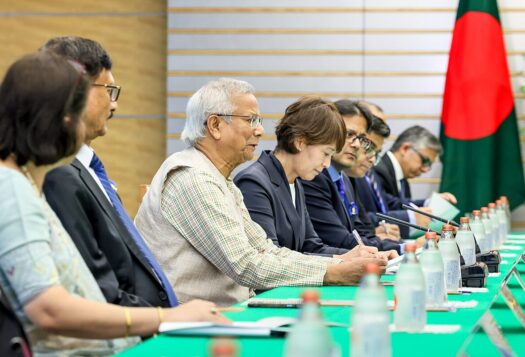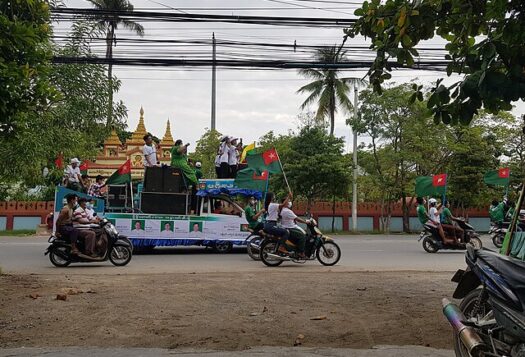
Right-wing populism has captured the imagination of millions worldwide by rebuking the consensus of the elite. Brazen displays of ethnocentrism coupled with vehement opposition to low-skilled immigration, as seen during Donald Trump’s election campaign, have become the movement’s most widely observable manifestation. In India, the return to power of the Bharatiya Janata Party (BJP) in 2014 through Narendra Modi has been accompanied by widespread fear among those that attribute Modi’s rise to Hindu nationalism. However, contrary to the liberal perception that the BJP’s success is built upon religious sectarianism, the BJP has actually employed a quiet, inclusive strategy that has begun to pay political dividends.
The BJP’s success, we argue, can be explained by a “concentric circles” model (refer figure 1 below). It captures the rebranding strategy of the BJP, with the party at the model’s epicenter. Based on the proximity of social groups to the party’s ideology, they have been organized into concentric circles. The group closest to the party’s traditional ideology is found in the first concentric circle, while the group farthest from it is listed in the last concentric circle. We argue that Modi is gradually increasing his electoral base by finding common ground with unlikely allies, and going beyond the party’s core ideology, to co-opt voters like the ones placed in concentric circles farther from the core. The model offers a contrarian perspective to the preponderant notion that the BJP’s success is driven by Hindutva, an ideology that seeks to define India in terms of Hindu values.
Figure 1: Modi’s Concentric Circles Model
![]() The first concentric circle from the core comprises the Hindu upper castes, a constituency that has consistently voted for and identifies with the BJP’s ideology or its “traditional base,” as we call it. The mere nomination of Modi, perceived by this first circle as the voice of Hindutva, was enough to secure their confidence.
The first concentric circle from the core comprises the Hindu upper castes, a constituency that has consistently voted for and identifies with the BJP’s ideology or its “traditional base,” as we call it. The mere nomination of Modi, perceived by this first circle as the voice of Hindutva, was enough to secure their confidence.
The second concentric circle comprises other backward classes (OBCs) and the scheduled castes (SC), a large group of socially disadvantaged communities. The term “Mandalization”, named after the Mandal Commission of 1978, refers to a process by which these groups attained political power in the Indian heartland. The process began with the commission guaranteeing these groups affirmative action in government jobs and eventually led to a rise in political consciousness among the OBCs and SCs. However, political parties that rose to power at the state-government level in North India post Mandalization largely catered to the interests of the Yadav community while others remained neglected. The neglect eventually turned into an anti-Yadav grouse on the part of OBCs and SCs.
The BJP recognized and tapped into this schism. The BJP first publicly stated that it was open to making further provisions in affirmative action for the hitherto neglected Most Backward Classes in 2012. More recently, in the 2017 Uttar Pradesh assembly elections, it embarked on a three-pronged strategy to accommodate this Non-Yadav OBC base. A Non-Yadav OBC was appointed the state party president while other important office bearers in districts were also appointed from these communities. Additionally, the Non-Yadav OBC communities got the largest share of the party’s tickets in the election. The result was that the BJP and its allies won in seventy-five out of eighty-five reserved seats in UP, a state of prime significance in Indian politics because it contributes the most parliamentarians to the Lok Sabha at 80 out of 543. The Modi government’s continued attempts to implement its stated objective of affirmative action for hitherto neglected social groups, through recently-announced measures such as raising the ceiling for OBC jobs, indicates the BJP’s desire to strengthen its widening social base. This push for affirmative action despite the prevailing upper caste prejudice against reservations is also a radical departure from its traditional populist playbook.
Despite succeeding in diversifying its base, the BJP continues to be plagued by a publicly-perceived opposition to incorporating India’s minority groups in their vision. This perception remains the primary reason for the BJP being in a state of “dominance without hegemony“. But the BJP may have begun to remedy this by focusing on recruiting the Muslim minority community into its concentric circles starting with the incorporation of Muslim women. The shadow of the Shah Bano case and the opposition’s attempt to link any critique of Muslim personal law to an attack on Islam itself led to the marginalization of the genuine concerns of Muslim women. The Modi government was the first in the history of independent India to publicly back the discontinuation of the divorce practice of Triple Talaq. This, many argue, won them considerable goodwill among Muslim women at the expense of the Muslim clergy. Additionally, Modi’s recent public condemnation of violence in the name of religion during his Independence Day speech may have been a delayed but important symbolic overture to the Muslim community while sending a stern signal to hotheads within his party. With these actions, which go against the perceived majoritarian tendencies of the BJP and its traditional base, the party is attempting to incorporate marginalized religious minorities into its diversifying social base.
Modi’s BJP has notably reinvented itself to accommodate diverse domestic social groups, a trend that is apparent through the concentric circle model. The political climate is constantly changing, challenging preconceived notions of what a party and its voting population truly are. Arguably, the current dispensation in India is not a right-wing populist entity but rather an ideologically-flexible political machine that pragmatically tweaks its core ideology in pursuit of sustained electoral success.
***
Image 1: Presidenciamx via Flickr (cropped)
Image 2: Created using Piktochart


